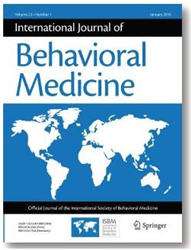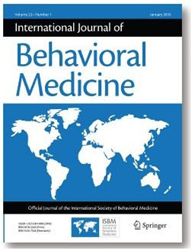
This issue of IJBM illustrates the innovative use of salivary bioscience to answer important behavioral medicine questions.
CARLSBAD, Calif. (PRWEB)
June 15, 2020
For researchers in biobehavioral science, Salimetrics has been a reliable partner for over 25 years, providing needed support to navigate research opportunities in the multidisciplinary field of Salivary Bioscience. Utilizing knowledge gained from saliva and oral fluids, Salimetrics continues to facilitate new milestones through an expanding line of high-quality collection devices and assays. Recently, the field has passed several milestones, including saliva-based assays for COVID-19, the release of a foundational reference guide, “Salivary Bioscience Foundations of Interdisciplinary Saliva Research and Applications”, and the first special issue of an international journal devoted to Salivary Bisocience from the IJBM.
The International Journal of Behavioral Medicine (IJBM) is the official scientific journal of the International Society for Behavioral Medicine (ISBM) which aims to present the best theoretically driven, evidence-based work in the field of behavioral medicine from around the globe. The recently published IJBM Special Issue emphasizes saliva-based research utilizing varied research designs (i.e., experimental, longitudinal, dyadic), incorporating a broad array of salivary analytes, and investigating the influence of psychological and social factors on human health. “This issue of IJBM illustrates the innovative use of salivary bioscience to answer important behavioral medicine questions,” says Michael Hoyt, Ph.D., of the Population Health and Disease Prevention and the Chao Family Comprehensive Cancer Center, University of California, Irvine and article contributor. “The interdisciplinary nature of behavioral medicine has expanded and so has its basic scientific and clinical practice missions. It’s distinguished history in understanding behavioral influences on the onset, prevention, and management of disease and on the promotion of well-being and health points the way toward a future of continued innovation and discovery.”
The special issue also features an overview of the use of salivary measures in behavioral medicine with original salivary bioscience studies, reviews of two prominent salivary markers (estradiol and alpha-amylase), and guidance on the physiometrics of salivary data. Several of the studies, supported by Salimetrics tools, were selected as representative of expanding critical mass in behavioral medicine. Specific highlights include:
Hoyt et al., “Salivary Bioscience and the Future of Behavioral Medicine.” This article introduces Salivary Bioscience in Behavioral Medicine and chronicles the overarching aims by translating saliva specimen data to identify mechanisms, decode moderating processes that turn adversity into risk, and verify the impact of clinical intervention.
Segerstrom et al., “Physiometrics in Salivary Bioscience.” This article highlights how studies depend on accurate estimation in statistical models through sample size but also, critically, reliability of the measure itself, and explores which study designs call for stable and generalizable measures.
Riis et al., “Long-Term Associations Between Prenatal Maternal Cortisol and Child Neuroendocrine-Immune Regulation.” This study investigates the relationship of prenatal factors and neuroendocrine-immune dynamics over time. The findings suggest prenatal maternal HPA activity moderates child neuroendocrine-immune functioning.
Eiden et al., “Prenatal Tobacco & Cannabis Exposure: Associations With Cortisol Reactivity in Early School Age Children.” This study lends insight into the potential impact of prenatal tobacco and cannabis exposure and physiological stress responses in later development. Results suggest that prenatal polysubstance exposure is associated with greater risk for lower cortisol response in children.
As Salivary Bioscience continues to expand into new disciplines, Salimetrics is well positioned to provide new, high-quality tools that further advance the field. “We’ve been collaborating with infectious disease researchers for over five years and began our infectious disease initiative about one year ago. This shift in focus made it possible for Salimetrics to have the needed salivary bioscience tools for researchers to monitor inflammation and infectious diseases using oral fluids,” says Supriya Gaitonde, Ph.D., Salimetrics Senior Applications Scientist. “Who is on your research team matters, and Salimetrics has acquired the unique knowledge to get the science right. Our knowledge serves the scientific community, and we give researchers the most effective tools to complete their study.”
Researchers can Contact Salimetrics for more information or review the International Journal for Behavioral Medicine Special Issue on the Springer Website. For more detailed information and examples of the application of salivary bioscience tools in a diverse range of disciplines, readers can refer to; “Salivary Bioscience Foundations of Interdisciplinary Saliva Research and Applications”.
About Salimetrics
Salimetrics’ assay kits and CLIA-certified testing services are used to measure salivary analytes related to stress, behavior and development, inflammation, sleep, reproduction, health and immune function. Founded in 1998 by Douglas A. Granger, Ph.D., Salimetrics, LLC support CROs, pharmaceuticals, academic researchers and the immunodiagnostic industry around the world with innovative immunoassay products, non-invasive saliva collection methods, and laboratory testing services.
Share article on social media or email:

